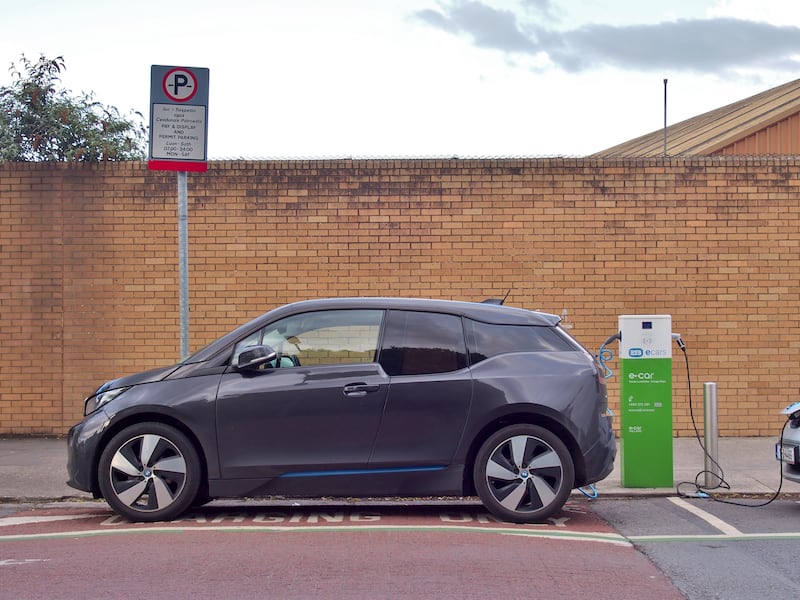In 2010, the Green minister for energy, Eamon Ryan said Ireland should strive to be a world leader in electric car development for its potential knowledge benefits as much as for its ability to reduce our oil dependency.
He told a gathering of the Irish motor industry that Ireland had “certain advantages” as an island: “The distances are reasonably short, and we have large volumes of renewable power.”
Ryan argued that Ireland was “well placed to be one of the first places to get all the spin-off benefits and then sell on our knowledge to the rest of the world”.
Fast forward 14 years and data from eco think-tank Transport & Environment (T&E) shows that at the end of last year Ireland languished at the bottom of the table alongside Cyprus and Malta when it came to meeting its 2024 targets for EV-charging installations in the EU.
READ MORE
The global recession played its part in derailing Ireland as a pioneer in EV development. But other EU states hit hard by the financial crisis have met or exceeded their targets for EV infrastructure developments.
On Monday the Government published yet another plan for expanding Ireland’s EV charging infrastructure.
Much of it is merely a repeat of earlier announcements, this one focused on the public charging infrastructure on our national roads. A cornerstone of the report is the promise to provide rapid charging points at 60km intervals along motorway routes.
While it may seem like we are finally moving on to the front foot, it merely meets a requirement of the EU’s Alternative Fuel Infrastructure Regulation (AFIR).
For the 500km designated the ‘core road network’ the State must install 400kW charging pools on the road at 60km intervals in both directions by 2025
Ireland has 5,300km of national road network. Under AFIR, by 2025 member states are required to deliver fast charging to the main transport corridors, the so-called “trans-European transport (TEN-T) network” which makes up 2,200km of our national roads in Ireland.
For the 500km designated the “core road network” – such as the M1 from the Border to Dublin – the State must install 400kW charging pools on the road at 60km intervals in both directions by 2025.
By 2027 that must increase to 600kW every 60km, plus the State must install 300kW of charging supply every 60km on the remaining 1,700km of the TEN-T network, such as M6 from Dublin to Galway.
According to the T&E report, at the end of last year Ireland had met just 35 per cent of its AFIR target for 2024. Portugal, with a similar EV adoption as Ireland had met 91 per cent of its 2024 target.
The majority of EU countries had already exceeded the target, with an EU average of 129 per cent. Only four countries – Malta, Cyprus, Ireland and Luxembourg – had achieved less than 50 per cent of their 2024 public charging infrastructure target.
Irish Times journalist Neil Briscoe recently reported on his drive from Munich to Dublin in a BMW EV. Travelling through France, he found rapid chargers regularly along his route to Cherbourg, “usually with at least 10 or a dozen connectors, most of them offering between 300kW and 350kW of power and every single one I visited worked flawlessly. Never had to queue, either.”
Clara Ouvrier, electric vehicle policy officer at T&E, said: “Ireland has not yet reached its charging deployment targets for 2024, when other EU countries with similar EV penetration rates have exceeded them already.
“More needs to be done to ramp up the number of public chargers. That being said, the situation is not a desperate one, and Ireland could still comply if it deploys chargers consistently enough in the remaining months before the deadline.”
The Department of Transport’s latest plan states there are more than 2,400 public charging points across the State. These are operated by a mix of providers including ESB e-cars, Easygo, ChargePoint, Ionity and Tesla, plus some filling station forecourt operators.

One potential solution would be to focus on installing charging hubs in the current fuel forecourt network, which offer ancillary services like shops and cafes where motorists can wait while their cars are charging.
According to Kevin McPartland of Fuels for Ireland, which represents forecourt operators and fuel providers, these operators are eager to embrace the EV charging revolution.
“It is clear to retailers that the future business will not come from selling petrol and diesel so there is not just an environmental but a business imperative as well to adopt to alternatives,” he said.
He says one of the biggest hurdles that forecourt operators face when it comes to installing charge points is the lengthy planning process. While the charging points do not require planning, the faster chargers often require substations to be built, and these do require approval, as do any canopy covers and similar fixtures.
He points to one forecourt operator who estimated the cost of installing four ultra-fast chargers on its site at €500,000. And in this case, there were no planning challenges lodged.
“We have an EV charging subcommittee and at that recently, somebody talked about their lead-in time to install EV charging on a site is now two years,” McPartland said.
Potential future advances in technology is also an issue. As with EV buyers, forecourt retailers are eager to stay ahead of the technology curve. McPartland says they don’t want to have to replace the chargers in two or three years, particularly when the return on these investments in installations can take 10- to 12-years.
It was not that long ago that 22kW outlets were billed as “fast chargers”. Now, providers like Ionity can deliver up to 350kW, though most EVs cannot even charge at that rate at present.
[ Stalling EV sales in Europe could mean plug-in hybrids will be around for longerOpens in new window ]
There’s also the question of infrastructure grants. With regular changes and amendments to the supports for EVs and its infrastructure, it is understandable if owners of suitable locations for public charging points are waiting to see whether grants will be introduced if the Government struggles to deliver on its plans.
Having ample public charging points is one issue; ensuring they are working is another.
The T&E report recommends that charger reliability is kept to 98 per cent or better, an ambitious target considering how frequently EV drivers complain of broken chargers.
ESB e-cars says its current charging infrastructure is running at 99 per cent reliability. Yet, many EV owners complain that it’s not until they go to charge that they discover the problems. And at that stage of their journey, options can be limited.
The T&E report also calls for charge point operators to ensure their public chargers are easy to use, and do not require a plethora of smartphone apps or your personal details before you can get a charge.
And then there is the price. Electricity pricing lacks transparency and a myriad of subscription models from car makers and charge providers makes it difficult for consumers to estimate the best deals.
[ Ireland is second most expensive for EV charging in Europe, says reportOpens in new window ]
While EV drivers are rarely in a position to shop around – given the paucity of charge points and the limited range of many EVs – even if they could enjoy that luxury, it can be difficult to identify the best deals.
Early adopters of EVs knew they were pioneering new technology, that the supporting infrastructure was in its infancy and the tech was patchy.
But for EVs to become the mainstay of private motoring they need to be adopted by the mainstream market. These consumers, who regard the car as little more than a mode of transport, will not accept the excuse that “things will get better in time” or take heart in yet another strategic report for the decade ahead.
Back in the halcyon days of 2010, Ireland had a chance to take the lead in EVs. Now we are struggling to keep up. There has been no shortage of strategies, plans or promises, but ultimately what has always been required are a lot more charging points.
- Sign up for push alerts and have the best news, analysis and comment delivered directly to your phone
- Join The Irish Times on WhatsApp and stay up to date
- Listen to our Inside Politics podcast for the best political chat and analysis












